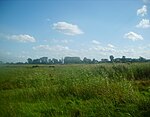Świna

The Świna (German: Swine; Pomeranian: Swina) is a channel in northwest Poland, between 2 and 4 km (1.2 and 2.5 miles) from the German border. It connects the Szczecin Lagoon with the Baltic Sea separating the islands of Uznam (German: Usedom) and Wolin (German: Wollin). It is a part of the Oder estuary, and carries about 75% of that river's waterflow (of the remainder, Peenestrom carries 15% and Dziwna 10%). It has a length of about 16 km (9.9 miles). Świnoujście is a major town at the end of the channel towards the Baltic Sea. The German Empire dammed and deepened the straits from 1874-1880 to create the Kaiserfahrt (Piast canal). It connects the northern part of the Świna directly with the Szczecin Lagoon and the Pomeranian harbor of Szczecin (Stettin). The straits thus gained importance as a direct waterway to the industrial city. The territory along the straits' path was transferred from Germany to Poland following World War II.
Excerpt from the Wikipedia article Świna (License: CC BY-SA 3.0, Authors, Images).Świna
Westmole, Świnoujście Chorzelin
Geographical coordinates (GPS) Address Nearby Places Show on map
Geographical coordinates (GPS)
| Latitude | Longitude |
|---|---|
| N 53.9225 ° | E 14.281111111111 ° |
Address
Westmole
72-602 Świnoujście, Chorzelin
West Pomeranian Voivodeship, Poland
Open on Google Maps










